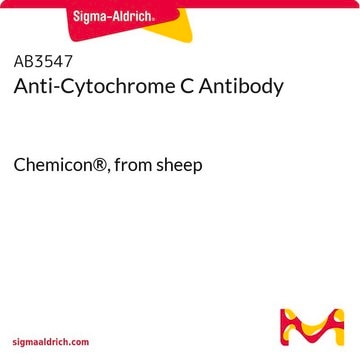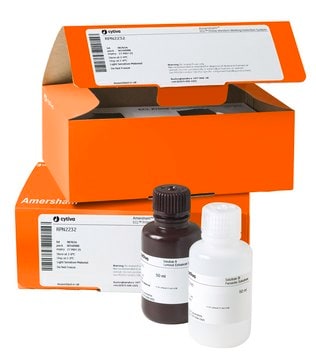05-673
Anti-phospho-Acetyl CoA Carboxylase (Ser79) Antibody, clone BK102
clone BK102, Upstate®, from mouse
Sign Into View Organizational & Contract Pricing
All Photos(1)
About This Item
UNSPSC Code:
12352203
eCl@ss:
32160702
NACRES:
NA.41
Recommended Products
biological source
mouse
Quality Level
antibody form
purified immunoglobulin
antibody product type
primary antibodies
clone
BK102, monoclonal
species reactivity
rat, mouse
manufacturer/tradename
Upstate®
technique(s)
western blot: suitable
isotype
IgG1λ
UniProt accession no.
shipped in
wet ice
target post-translational modification
phosphorylation (pSer79)
Gene Information
mouse ... Acaca(107476)
Specificity
Recognizes phosphorylated Acetyl CoA Carboxylase (Ser79).
Immunogen
Synthetic peptide corresponding to rat Acetyl CoA Carboxylase
Application
Detect phospho-Acetyl CoA Carboxylase (Ser79) using this Anti-phospho-Acetyl CoA Carboxylase (Ser79) Antibody, clone BK102 validated for use in WB.
Research Category
Signaling
Signaling
Research Sub Category
Insulin/Energy Signaling
Insulin/Energy Signaling
Quality
Routinely evaluated by immunoblot on HeLa acid extracts
Target description
257 kDa
Physical form
Format: Purified
Protein A Purified immunoglobulin in 0.1M Tris-Glycine, 0.15M NaCl and 0.05% sodium azide, pH 7.4.
Protein G Purified
Storage and Stability
Stable for 1 year at 2-8°C from date of receipt.
Analysis Note
Control
Acid extracts of HeLa cells
Acid extracts of HeLa cells
Legal Information
UPSTATE is a registered trademark of Merck KGaA, Darmstadt, Germany
Disclaimer
Unless otherwise stated in our catalog or other company documentation accompanying the product(s), our products are intended for research use only and are not to be used for any other purpose, which includes but is not limited to, unauthorized commercial uses, in vitro diagnostic uses, ex vivo or in vivo therapeutic uses or any type of consumption or application to humans or animals.
Not finding the right product?
Try our Product Selector Tool.
Storage Class Code
12 - Non Combustible Liquids
WGK
WGK 1
Flash Point(F)
Not applicable
Flash Point(C)
Not applicable
Certificates of Analysis (COA)
Search for Certificates of Analysis (COA) by entering the products Lot/Batch Number. Lot and Batch Numbers can be found on a product’s label following the words ‘Lot’ or ‘Batch’.
Already Own This Product?
Find documentation for the products that you have recently purchased in the Document Library.
Zhi-Ping Chen et al.
Diabetes, 52(9), 2205-2212 (2003-08-28)
The effect of exercise intensity on skeletal muscle AMP-activated protein kinase (AMPK) signaling and substrate metabolism was examined in eight men cycling for 20 min at each of three sequential intensities: low (40 +/- 2% VO(2) peak), medium (59 +/-
Tatyana G Kahn et al.
PLoS genetics, 10(7), e1004495-e1004495 (2014-07-11)
Polycomb Group (PcG) proteins are epigenetic repressors that control metazoan development and cell differentiation. In Drosophila, PcG proteins form five distinct complexes targeted to genes by Polycomb Response Elements (PREs). Of all PcG complexes PhoRC is the only one that
Ligen Lin et al.
PloS one, 9(1), e85636-e85636 (2014-01-24)
We have previously reported that the expression of mitochondrial deacetylase SIRT3 is high in the slow oxidative muscle and that the expression of muscle SIRT3 level is increased by dietary restriction or exercise training. To explore the function of SIRT3
Glenn K McConell et al.
The Journal of physiology, 598(18), 3859-3870 (2020-06-27)
AMP-activated protein kinase (AMPK) is considered a major regulator of skeletal muscle metabolism during exercise. However, we previously showed that, although AMPK activity increases by 8-10-fold during ∼120 min of exercise at ∼65% V ̇ O 2 peak
B E Kemp et al.
Trends in biochemical sciences, 24(1), 22-25 (1999-03-24)
The AMP-activated protein kinase (AMPK) is a member of a metabolite-sensing protein kinase family that is found in all eukaryotes. AMPK activity is regulated by vigorous exercise, nutrient starvation and ischemia/hypoxia, and modulates many aspects of mammalian cell metabolism. The
Our team of scientists has experience in all areas of research including Life Science, Material Science, Chemical Synthesis, Chromatography, Analytical and many others.
Contact Technical Service








